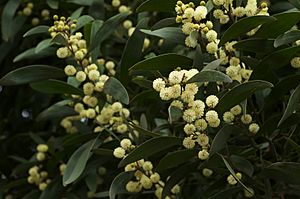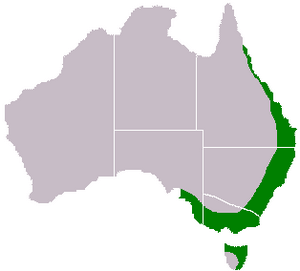Australian blackwood facts for kids
Quick facts for kids Australian blackwood |
|
|---|---|
 |
|
| Flowering twigs of Acacia melanoxylon | |
| Scientific classification | |
| Genus: |
Acacia
|
| Species: |
melanoxylon
|
 |
|
| Range of Acacia melanoxylon | |
| Synonyms | |
|
|
The Acacia melanoxylon, often called the Australian blackwood, is a type of Acacia tree. It is native to southeastern Australia. People also call it Blackwood, hickory, Tasmanian blackwood, or blackwood acacia. This tree is one of the most common Acacia species in eastern Australia. It can look a bit different depending on where it grows.
Contents
Description
This tree can grow quite tall, up to about 20 meters (65 feet). Its main trunk can be around 150 centimeters (5 feet) wide. Older trees have dark grey to black bark that looks scaly and has deep cracks.
Younger branches are smooth and have ribs. They can be angular or flat near their green tips. Sometimes, the stems of very young plants are a bit hairy.
Like most Acacia trees, the Australian blackwood has phyllodes instead of true leaves. Phyllodes are flattened leaf stems that act like leaves. These phyllodes are smooth, shiny, and feel leathery. They are dark green to grey-green. They are usually 4 to 16 centimeters (1.5 to 6 inches) long and 6 to 30 millimeters (0.2 to 1.2 inches) wide. They often have a narrow, spear-like shape and are straight or slightly curved. They also have three to five clear lines running along them.
The tree blooms between July and December in Australia. Its flowers grow in groups of two to eight. Each flower head is round, about 5 to 10 millimeters (0.2 to 0.4 inches) wide. They have 30 to 50 pale yellow to almost white flowers packed tightly together.
After the flowers, smooth, firm, paper-like seed pods grow. These pods are curved, twisted, or coiled. They are about 4 to 12 centimeters (1.5 to 4.7 inches) long and 5 to 8 millimeters (0.2 to 0.3 inches) wide. Inside, they hold seeds arranged lengthwise.
Taxonomy
The Australian blackwood was first officially described by a botanist named Robert Brown in 1813. This was part of a book called Hortus Kewensis. Later, in 1986, another botanist, Leslie Pedley, changed its name to Racosperma melanoxylon. But in 2006, it was changed back to the Acacia group. This tree has a few other old names, like Acacia arcuata.
Where it Grows
This tree naturally grows along the east coast of Australia. You can find it from Queensland in the north, through New South Wales and Victoria, and west into South Australia. It also grows along the east coast of Tasmania. It has also started growing on its own in Western Australia.
In New South Wales, it is common in coastal areas and up into the Great Dividing Range. It usually grows in wet sclerophyll forests or near cooler rainforests. It can grow in many different types of soil, especially sandy soils.
Timber
The wood from the Australian blackwood is very valuable. It is used to make beautiful furniture, musical instruments, and even parts of boats.
Appearance
The outer part of the wood, called sapwood, can be straw-colored to grey-white. It is clearly different from the inner wood, called heartwood. The heartwood is golden to dark brown and has darker rings from its growth.
The wood usually has straight grains, but sometimes they can be wavy or interlocked. If the wood is cut in a special way (quartersawn), it can show a pretty pattern called a "fiddleback figure." The wood is shiny and has a fine to medium texture.
The name "blackwood" might come from the dark stains it can leave on woodworkers' hands. This happens because the wood has a lot of a substance called tannin.
Properties
Australian blackwood timber is quite dense, weighing about 660 kilograms per cubic meter (41 pounds per cubic foot). It is strong when pressed, can handle impacts well, and is moderately stiff. It can make tools a bit dull when working with it, but it bends well. It's easy to nail or screw, but gluing it can sometimes be tricky. The wood takes stains easily and can be finished to look very nice.
This wood dries out easily after being cut. It doesn't change much in size or shape once it's dry.
However, furniture beetles, termites, and powder-post beetles can attack the wood. It is also hard to treat with wood preservatives.
Invasive Species
The Australian blackwood has been planted in many countries around the world. People use it for growing timber or as a pretty tree in gardens. Now, it grows in places like Africa, Asia, Europe, and parts of the Americas.
In some places, like South Africa and the Azores Islands in Portugal, it is considered a noxious weed. This means it grows too much and can harm native plants. In some areas of Tasmania, it is also seen as a pest. Sometimes, it's not used as a street tree anymore because its roots can damage sidewalks and pipes underground.
Uses
Indigenous Australians used this tree for many things. They made a pain-relieving medicine from it. They also used the wood to make spear-throwers and shields.
The wood is used for many items, such as wood panels, furniture, fancy cabinets, tools, and wooden barrels. It is similar in quality to walnut wood and can be shaped well with steam. The bark of the tree contains about 20% tannin, which can be used for tanning leather. It can also be used to make thin, decorative wood layers called veneers.
The tree's twigs and bark were sometimes used to poison fish for fishing. This tree can also help stop fires from spreading in rural areas.
Plain and patterned Australian blackwood is popular for making musical instruments. It's used for guitars, drums, Hawaiian ukuleles, violin bows, and organ pipes. Recently, it has become a good replacement for koa wood, which is also used in instruments.
Images for kids
See also
 In Spanish: Acacia melanoxylon para niños
In Spanish: Acacia melanoxylon para niños




